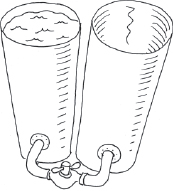Make: Electronics (4 page)
Authors: Charles Platt

The other ends of the leads terminate in metal spikes known as
probes
, which you will be touching to components when you want to make electrical measurements. The probes detect electricity; they don’t emit it in significant quantities. Therefore, they cannot hurt you unless you poke yourself with their sharp ends.
If your meter doesn’t do autoranging, each position on the dial will have a number beside it. This number means “no higher than.” For instance if you want to check a 6-volt battery, and one position on the voltage section of the dial is numbered 2 and the next position is numbered 20, position 2 means “no higher than 2 volts.” You have to go to the next position, which means “no higher than 20 volts.”
If you make a mistake and try to measure something inappropriate, the meter will show you an error message such as “E” or “L.” Turn the dial and try again.
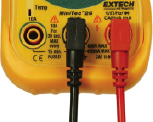
Figure 1-18
.
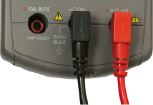
Figure 1-19
.

Figure 1-20.
To measure resistance and voltage, plug the black lead into the Common socket and the red lead into the Volts socket. Almost all meters have a separate socket where you must plug the red lead when you measure large currents in amps, but we’ll be dealing with this later.
Fundamentals
Ohms
We measure distance in miles or kilometers, weight in pounds or kilograms, temperature in Fahrenheit or Centigrade—and electrical resistance in ohms. The ohm is an international unit.
The Greek omega symbol (Ω) is used to indicate ohms, as shown in Figures 1-21 and 1-22. Letter K (or alternatively, KΩ) means a kilohm, which is 1,000 ohms. Letter M (or MΩ) means a megohm, which is 1,000,000 ohms.
Number of ohms | Usually | Abbreviated as |
1,000 ohms | 1 kilohm | 1KΩ or 1K |
10,000 ohms | 10 kilohms | 10KΩ or 10K |
100,000 ohms | 100 kilohms | 100KΩ or 100K |
1,000,000 ohms | 1 megohm | 1MΩ or 1M |
10,000,000 ohms | 10 megohms | 10MΩ or 10M |
A material that has very high resistance to electricity is known as an
insulator
. Most plastics, including the colored sheaths around wires, are insulators.
A material with very low resistance is a
conductor
. Metals such as copper, aluminum, silver, and gold are excellent conductors.

Figure 1-21.
The omega symbol is used internationally to indicate resistance on ohms.

Figure 1-22.
You’ll find it printed or written in a wide variety of styles.
Procedure
We’re going to use the meter to discover the electrical resistance of your tongue. First, set your meter to measure resistance. If it has autoranging, look to see whether it is displaying a K, meaning kilohms, or M, meaning megohms. If you have to set the range manually, begin with no less than 100,000 ohms (100K). See Figures 1-23 through 1-25.
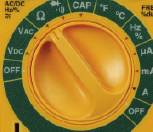
Figure 1-23
.
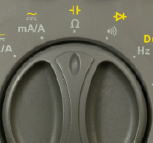
Figure 1-24
.
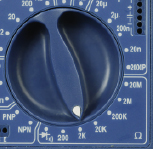
Figure 1-25.
To measure ohms, turn the dial to the ohm (omega) symbol. On an autoranging meter, you can then press the Range button repeatedly to display different ranges of resistance, or simply touch the probes to a resistance and wait for the meter to choose a range automatically. A manual meter requires you to select the range with the dial (you should set it to 100K or higher, to measure skin resistance). If you don’t get a meaningful reading, try a different range.
Touch the probes to your tongue, about an inch apart. Note the reading, which should be around 50K. Now put aside the probes, stick out your tongue, and use a tissue to dry it very carefully and thoroughly. Without allowing your tongue to become moist again, repeat the test, and the reading should be higher. Finally, press the probes against the skin of your hand or arm: you may get no reading at all, until you moisten your skin.
When your skin is moist (for instance, if you perspire), its electrical resistance decreases. This principle is used in lie detectors, because someone who knowingly tells a lie, under conditions of stress, tends to perspire.
A 9-volt battery contains chemicals that liberate electrons (particles of electricity), which want to flow from one terminal to the other as a result of a chemical reaction inside it. Think of the cells inside a battery as being like two water tanks—one of them full, the other empty. If they are connected with a pipe, water flows between them until their levels are equal. Figure 1-26 may help you visualize this. Similarly, when you open up an electrical pathway between the two sides of a battery, electrons flow between them, even if the pathway consists only of the moisture on your tongue.
Electrons flow more easily through some substances (such as a moist tongue) than others (such as a dry tongue).
